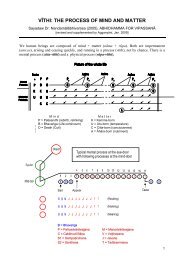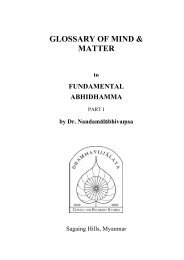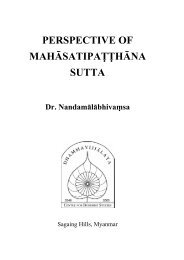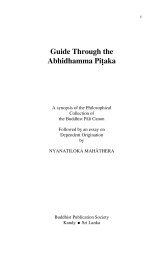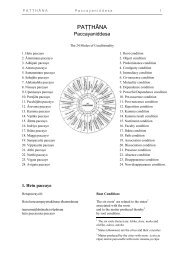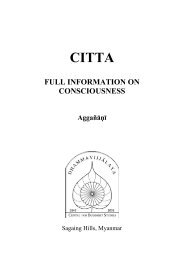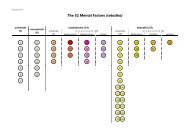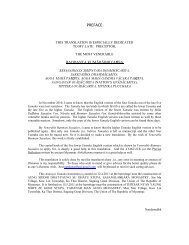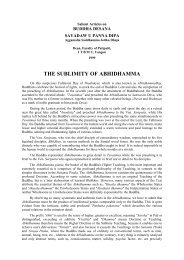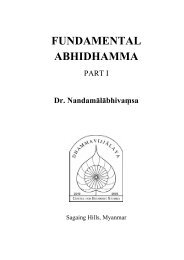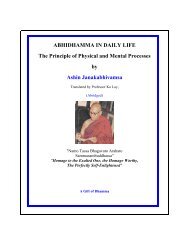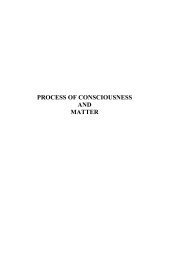Mahathera Ledi Sayadaw - Abhidhamma.com
Mahathera Ledi Sayadaw - Abhidhamma.com
Mahathera Ledi Sayadaw - Abhidhamma.com
You also want an ePaper? Increase the reach of your titles
YUMPU automatically turns print PDFs into web optimized ePapers that Google loves.
50. Sammuti-sacca, conventional or relative truth.<br />
51. Paramattha-sacca, or ultimate Truth.<br />
Of the two, conventional truth is the truthfulness of the customary terms used by the great<br />
majority of people, such as "Self exists", "a living soul exists" "men exist", "Devas exist", "Sakkas<br />
exist", "elephants exist", "head exists" and so on. This conventional truth is the opposite of<br />
untruth, and so can over<strong>com</strong>e it. It is not a lie or an untruth when people say:<br />
"There probably exists an immutable, permanent, one continuous self or living soul which is<br />
neither momentarily rising nor passing away throughout one existence," for this is the customary<br />
manner of speech of the great majority of people who have no intention whatever of deceiving<br />
others. But according to ultimate truth, it is reckond a Vippallasa or hallucination which<br />
erroneously regards impermanent as permanent and non-self as self. So long as this erroneous<br />
view remains undestroyed, one can never escape from the evils of Samsara, the wheel of life. All<br />
of the foregoing alike holds good when people say "a person exists" and so on.<br />
Ultimate truth is the absolute truthfulness of assertion or negative in full and <strong>com</strong>plete accordance<br />
with what is actual, the elementary, fundamental qualities of phenomena. Here stating such truth<br />
in affirmative form, one may say:"The element of solidity exists", "the element of extension<br />
exists", "the element of cohesion exists", "the element of kinetic energy exists", "mind exists"<br />
"consciousness exists", "contact, feeling and perception exist", "material aggregates exist" and so<br />
on. And expressing such truth in a negative form, it can be said: "No self exists", "no living soul<br />
exists", no person exists", "no being exists", "neither does an elephant exist", "nor do hands, nor<br />
legs, nor any members of the body exist", "neither does a man exist nor a Deva" and so on. In<br />
saying here "No self exists" "no living soul exists" we mean that there is no such ultimate entity as<br />
a self or living soul which persists unchanged during the whole term of life, without momentarily<br />
<strong>com</strong>ing to be and passing away. In the expression: "No being exists" and so forth, what is meant is<br />
that nothing actually exists but material and mental elements. These elements are neither persons<br />
nor beings, nor men, nor Devas etc. Therefore there is seperate being or person apart from the<br />
elements. The ultimate truth is the diametrical opposite of the hallucination, and so can confute it.<br />
One who is thus able to confute or reject the hallucination can escape from the evils of Samsara,<br />
the evolution of life.<br />
According to conventional truth, a person exists, a being exists; a person or a being continually<br />
transmigrates from one existence to another in the ocean of life. But to ultimate truth, neither a<br />
person nor a being exists, and there is no one who transmigrates from one existence to another.<br />
Here, it may be asked: "Do not these two truths seem to be as poles asunder" Of course they<br />
seem to be so. Nevertheless we may bring them together. Have we not said: "According to<br />
conventional truth" and "according to ultimate truth" Each kind of truth accordingly is truthful as<br />
regards its own mode of expression. Hence if one man should say that there exists a person or a<br />
being according to conventional truth, the other to whom he speaks ought not to contradict him,<br />
for these conventional terms describe what apparently exists. And likewise, if the other says there<br />
exists neither a person nor a being, according to ultimate truth, the former ought not to deny this,<br />
for in the ultimate sense, material and mental phenomena alone truly exist and in strict reality they<br />
know no person or being. For example: Men dig up lumps of earth from certain places, pound<br />
them into dust, knead this dust with water into clay, and from this clay make various kinds of<br />
useful pots, jars and cups. Thus there exist various kinds of pots, jars and cups in the world. Now<br />
when discussion takes place on this subject, if it were asked: "Are there earthen pots and cups in<br />
this world" The answer, according to the conventional truth should be given in the affirmative,<br />
and according to the ultimate truth, in the negative, since this kind of truth admits only the<br />
positive existence of earth out of which the pots and so forth were made. Of these two answers the<br />
former requires no explanation in as much as it is an answer according to the established usage;<br />
but as regards the latter, some explanation is needed. In the objects that we called "earthen pots"<br />
and "earthen cups", what really exists is only earth; not pots nor cups, in the sense of ultimate<br />
truth: because the term "earth" applies properly not to pots and cups but to actual substantial earth.




